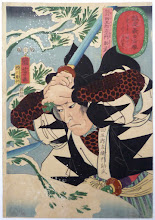I've been busy, but don't despair, I'm still continuing with this series. Who knows, eventually it may even get me to finally read the Immortals Set (which I only have on .pdf, so I haven't given it a full reading before).
Our next section, before the CYOA style solo adventure itself, is a one page section detailing battles. It's still not the full D&D combat system, but it's getting closer. The tutorial already showed how to make attack rolls and saving throws. In this section, we're introduced to the idea of rolling for damage, and how both your own attacks and the monster attacks are now more deadly.
One interesting note is that for the CYOA solo adventure, all weapons do 1d6 damage. I'll find out later if variable weapon damage is listed as optional or not (yeah, I could just flip ahead...). When we were kids, we latched onto that chart showing what dice to roll for what weapons, and stuck with it, if it was presented as optional. In our most recent Vaults of Ur games, we were experimenting with an all weapons do d6 rule, but I think we'll go back to regular variable damage by weapon from the next session. As a DM, though, I often default to any weapon-using enemy only using a d6 for damage for simplicity, rather than figure out how many orcs are packing swords, how many have hand axes, and how many have daggers. I tend to discourage the low level "salvage all the weapons and armor from the goblins" style play, so it's usually not a big deal exactly what weapons they are carrying, at least for melee purposes.
Because this is a training module, it tells us that if we die, just start over again. Having played enough Atari (the Nintendo hadn't made it out yet) and arcade games, that wasn't weird for me. This was a game, after all. And I do remember that it took me multiple tries before I'd explored all of the areas, as I did die fairly often. I think this is a good thing. In the initial tutorial, you almost can't fail (only against Bargle's goblin do you have a chance to drop to 0 hp). Here, you can and likely WILL die often. It's a good lesson to be learned by new folks. It's also something video game designers might want to think about, as most in-game tutorials I've played through have had the kid gloves on. And they feel like a waste of time to me. I'd rather just jump in and learn while playing. But maybe that's just me.
One issue I have with the style of these introductory adventures is the lack of RP or options to outwit the enemies. This page gives you fairly standard advice about how D&D combat works mechanically, but it limits the perspective to the "roll to hit, roll damage, rinse and repeat" mindset that we often fall into. In this respect, some of the Endless Quest books, like Dungeon of Dread and Light on Quest's Mountain did a better job of preparing me for D&D play, as they included talking/negotiating with monsters, tricking them, or coming up with clever plans to tip the combat odds in my favor.
The page ends with the advice to keep notes of combat details, treasure earned, and monsters defeated on scrap paper, so there is a record after the adventure. For a while as a kid, I did try keeping it all in my head, and sometimes it worked, other times we just gave out treasure and XP after each encounter. These days, I do as advised and keep a page of scrap paper nearby when I play or DM. The page also gives us some advice about mapping the dungeon, both to avoid getting lost, and to note where dangerous creatures are so you can return to them later when you feel confident about facing them - subtle advice on old school play that gets lost on many, I think. Not only mapping, but the idea that you would scout out where monsters are, and only battle them when you're ready for them, rather than kicking in all the doors and rolling initiative regardless of what's there.
Forward into the Past
44 minutes ago






My simplified WEAPON versus ARMOR system
ReplyDelete...
When any die is rerolled, you must accept the result of the second roll. A dice can only be rerolled once.
…
On the damage dice roll, ones will be rerolled if the attack is fire, force or slashing in nature and the defender or target is wearing soft armor (padded, leather) . This is the default armor type for most birds, plants and mammals.
...
On the damage dice roll, ones will be rerolled if the attack is acid, cold or piercing in nature and the defender or target is wearing flexible/ mail armor.This is the default armor for most reptiles and sea monsters.
...
On the damage dice roll, ones will be rerolled if attack is electricity, sonic or bludgeoning in nature and the defender or target is wearing rigid/ plate armor.This is the default armor type for most insects, crustaceans and dragons.